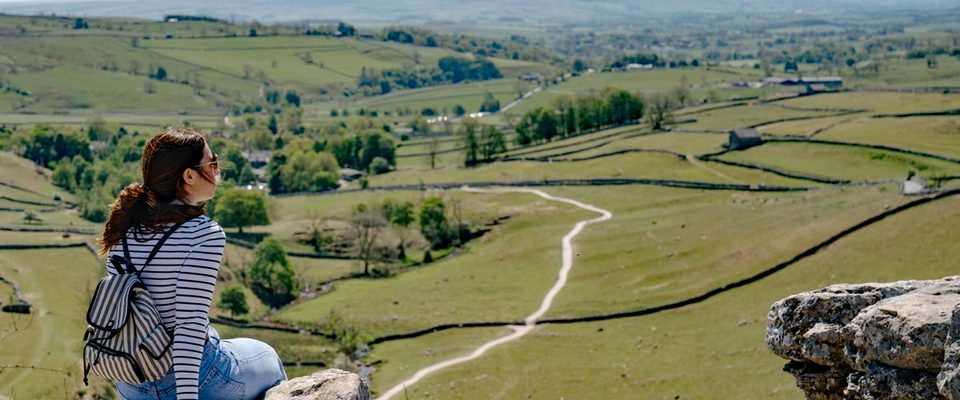- Index
- Castleton To Lealholm Walk
Castleton to Lealholm Walk
The moorland villages of Castleton and Danby set the scene on this 7½-mile linear walk that wends its way from the higher moors down to the gentler reaches of the Esk Valley around Lealholm.
About Castleton to Lealholm Walk
The moorland villages of Castleton and Danby set the scene on this 7½-mile linear walk that wends its way from the higher moors down to the gentler reaches of the Esk Valley around Lealholm. The route passes The Moors National Park Centre, just outside Danby, whose hands-on activities, art gallery, play areas, woodland bird hide, grounds and café are a tempting stop. Pushing on, you climb up the daleside for fabulous views from Danby Beacon, before descending off the moors to pretty, riverside Lealholm. The Esk Valley Railway makes this an easy walk to do by public transport – take the train up to Castleton and then walk back down to Lealholm, following signs, waymarks and the salmon symbol for the ‘Esk Valley Walk’.
Great for: big-sky views, history lovers, nature lovers Length:7½ miles (12km) Time: 4 hours Start/Finish: Castleton Moor station/Lealholm station Grid Ref: NZ 684 084 OS Map: Ordnance Survey OL26 & OL27
Refreshments: Castleton, Danby, The Moors Centre, Lealholm
Toilets: Castleton, Danby, The Moors Centre, Lealholm
About this walk
This is the second section (EVW2) of the Esk Valley Walk, a 37-mile ‘Regional Route’ from Castleton to Whitby. Put all 4 sections together to complete the route, or walk each section individually for great days out in the Esk Valley – also see EVW1, EVW3 and EVW4.
The first half of the route follows woodland and field paths, with gates and one wall-stile enroute and two short sections on minor roads. There’s a steep climb after point 11 up to the moor, after which the route follows the moorland road to Danby Beacon and then a well-defined moorland track towards Lealholm. Conditions on the moor can change quickly, even in summer, and visibility is sometimes poor.
Dogs: Please keep your dog under control at all times, and always on a short lead near livestock. In the moorland sections of the walk dogs must stay on the public right of way, and always be kept on a short lead between 1 March and 31 July when birds are nesting on the ground. Sorry, but dogs are not allowed in the buildings at The Moors Centre.
Castleton’s royal connections
The small area of woodland known as Danby Park, outside Castleton, is actually the remnant of a medieval deer park. In the Middle Ages, deer hunting was an exclusively royal pastime – anyone else who wanted to hunt had to apply to the king for permission (and there were dire consequences for transgressors). To get around this, wealthy landowners enclosed their own deer parks for private hunting. This particular deer park belonged to the powerful De Brus family, originally from Normandy, whose first base in England was Castleton (the Norman castle here was eventually demolished in the 13th century). The De Brus family interests later became divided between England and Scotland – and, six generations after they first arrived in Castleton, a Scottish De Brus (by now a Bruce) would claim the crown as Robert the Bruce, 14th-century king of Scotland and hero of Scottish independence.
Danby Beacon
There are sweeping 360-degree views from the high moorland at Danby Beacon, which has been the site of a warning post – in times of possible invasion – since at least the 16th century. The current beacon here dates from 2008, lit now in celebration rather than to warn of approaching warships in the distant North Sea. An RAF radar station was sited here in World War II, and tracked the first enemy plane to be shot down over England (February 1940), which crashed near Whitby. One of the RAF pilots that day was Flight-Lieutenant (later Group Captain) Peter Townsend – later notorious for his relationship with Princess Margaret, the Queen’s sister.
Oakley Walls
Evidence of early man – going back at least 4,000 years – can still be found in many places on the moors. Burial mounds (known as ‘howes’), boundary dykes and the remains of ancient field systems are typical of the archaeological landscapes in the National Park. On the open moorland they often stand out as the only visible landscape features, although in some cases they are so camouflaged by vegetation that it takes an expert to spot them. The moors around Danby were surveyed in 1988 and over 400 sites of archaeological interest were found. They range from early prehistoric tool production sites, which may be over 6,000 years old, to 19th-century boundary stones. Along Oakley Walls two prehistoric cist burials were discovered by the farmer in 1946. These consisted of crudely constructed stone chambers which contained cremated bones – they may have been constructed as long as 4,000 years ago.
Did you know? The Moors National Park Centre, in Danby, was originally a seventeenth-century farmhouse, later converted into a lodge (belonging to the Danby Estate), which was used as the base for grouse-shooting parties on the surrounding moors.


